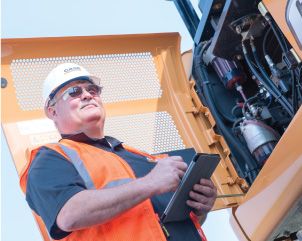Best Practices
Quick Coupler Safety Tips
Quick couplers are used on most job sites. Using quick couplers safely and responsibly can reduce risk of injury and damage on the job. Follow the below tips to make sure you are taking proper precautions when using quick couplers for your attachments.
Take Precautions
Train your operators
To prevent accidents related to quick coupler systems, thoroughly train operators in their use. All operators and supervisors should receive training on making visual inspections, the procedures for engaging attachments, and methods of evaluating and testing connections.
Install cautionary labels
Most excavator and quick coupler manufacturers provide warning labels reminding operators not to use the coupler without a safety pin. Warning labels should be placed in the cab where the operator can clearly see them as well as on the dipper arm. The condition of the labels should be inspected daily, and the labels should be replaced if they become damaged or illegible.
Only use approved attachments
Do not use attachments that exceed the limits outlined by the excavator and coupler manufacturers. Not all manufacturers approve the use of breakers or other attachments. Always consult the coupler manufacturer when uncertain about attachment use.
Upgrade your equipment
Newer quick coupler models are specifically designed to prevent unexpected release of attachments. If you are using an older model quick coupler, upgrading to a new system may help prevent accidents. Alternatively, you can install retrofits.
Maintain Your Couplers
Inspect quick couplers regularly
Visually inspect quick couplers before each use to ensure that they are not subject to hazards associated with accidental release. Quick couplers should be inspected before each use to ensure that the safety pin is in the correct position. With many coupler systems the operator will need to manually inspect the safety pin. With fully automated systems the operator may be able to visually verify that the safety pin is in position from the cab.
Regularly maintain your couplers
Maintenance is essential to safe operation of quick couplers. Regular maintenance can prevent deterioration and wear of quick couplers. Manufacturer's preventative maintenance should be strictly observed to ensure safety.
Practice Safe Operation
Exercise caution when changing buckets
High-risk activities, such as bucket changing and attachment testing, should be designated to clearly defined areas. The operator must ensure that the safety pin is in place before lifting the quick coupler. Once the bucket is attached, secured, and checked, the quick coupler should be shaken vigorously to ensure a secure connection with the coupler.
Removing the quick coupler safely
Do not remove the quick coupler from the dipper while a bucket or attachment is still connected, as this can damage the coupler and the attachment. For safe removal, lower the coupler onto a structure at level height. Release all hydraulic pressure from the circuit and make sure that the machine is off before removing. To prevent contamination, immediately plug the quick coupler hoses and pipe work of the machine after disconnecting. After disconnecting the coupler, remove all dirt and debris from the operating mechanism before placing in storage.
Looking for attachments for your machine? Talk to our rental experts about renting one today.

